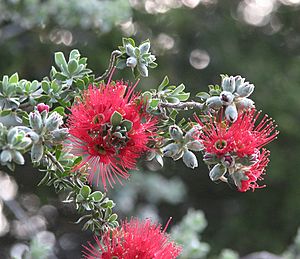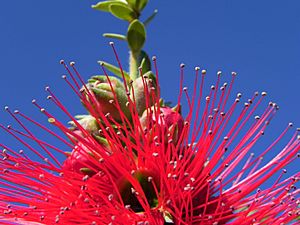Granite kunzea facts for kids
Quick facts for kids Granite kunzea |
|
|---|---|
 |
|
| Scientific classification | |
| Genus: |
Kunzea
|
| Species: |
pulchella
|
| Synonyms | |
The Kunzea pulchella, also known as granite kunzea, is a special flowering plant. It belongs to the myrtle family, called Myrtaceae. This plant is found only in the south-west part of Western Australia.
It's a shrub with branches that spread out. Its leaves are shaped like eggs or spears. The plant has groups of pretty red flowers. Each flower grows on a short stem, so you can see the branch between the flowers.
Contents
What Does Granite Kunzea Look Like?
Granite kunzea is a spreading shrub. It usually grows to be about 0.6 to 3 metres (2 to 10 feet) tall. It often has only a few side branches. The branches can be a bit hairy.
Its leaves grow one after another along the stem. Each leaf has a small stalk, about 1 millimetre (0.04 inches) long. The leaf itself is usually 5 to 14 millimetres (0.2 to 0.6 inches) long. It is also 2.5 to 5.5 millimetres (0.1 to 0.2 inches) wide. The leaves are shaped like an egg or a spear, with the narrower end at the bottom. Both sides of the leaves feel silky and hairy.
Granite Kunzea Flowers
The flowers grow in loose groups of 6 to 14. Each flower sits on a stalk that is 2.5 to 4.5 millimetres (0.10 to 0.18 inches) long. These flowers grow at the ends of branches. Sometimes, the branches keep growing even while the plant is flowering.
At the base of each flower, there are leaf-like parts called bracts. These are egg-shaped and about 4.5 to 6 millimetres (0.18 to 0.24 inches) long. There are also smaller parts called bracteoles. These fall off as the flower grows.
The base of the flower, called the hypanthium, is 4 to 5 millimetres (0.16 to 0.20 inches) long. It is very hairy on the outside. There are five sepals, which are like small leaves that protect the flower bud. These sepals are hairy, pointed, and triangular. They are 2 to 3.5 millimetres (0.08 to 0.14 inches) long. They stay on the fruit as it ripens.
The five petals are a deep red colour. They are almost round and 3.5 to 5 millimetres (0.14 to 0.20 inches) long. Each flower has more than 70 bright red stamens. These are the parts that hold pollen. They are 10 to 17 millimetres (0.39 to 0.67 inches) long. This means they are three or four times longer than the petals!
Flower Colour Variations
Some granite kunzea plants have white or pale cream-coloured flowers. These are usually found in the eastern part of where the plant grows. Pink flowers can be seen in a special area where the white and red forms meet. This area includes places like Elachbutting and Frog Rock.
The white flowers might help attract moths at night. This is important for pollination in drier areas.
Fruit and Unique Features
Granite kunzea flowers from June to November. After flowering, it produces fruit. The fruit is a broad, urn-shaped capsule. It is 4 to 5 millimetres (0.16 to 0.20 inches) long. The sepals stay attached to the fruit, standing upright.
What makes this plant special are its red flowers. Also, its sepals stay on the fruit, and the fruit itself falls off when ripe. Its egg-shaped leaves and triangular sepals help tell it apart. For example, it looks different from Kunzea baxteri, which also has red flowers.
How Granite Kunzea Got Its Name
This plant was first officially described in 1839. A scientist named John Lindley gave it the name Salisia pulchella. He wrote about it in a book called A Sketch of the Vegetation of the Swan River Colony.
Later, in 1966, another scientist named Alex George changed its name. He renamed it Kunzea pulchella. He published this change in a magazine called The Western Australian Naturalist.
The second part of its name, pulchella, comes from a Latin word. Pulcher means "pretty". So, pulchella means "beautiful little".
Where Does Granite Kunzea Grow?
Granite kunzea likes to grow in sandy or clay soils. You often find it near or on top of granite rocks in open scrubland. It is very common on the granite outcrops of Western Australia. These are rocky areas in the drier wheatbelt and goldfields regions.
The plant loves to grow in narrow cracks in the granite. It holds on very tightly to these spots. Sometimes, an old plant living alone in a small crack on a granite rock can look like a tiny bonsai tree.
It grows across a large area in several biogeographic regions. These include the Avon Wheatbelt, Coolgardie, Jarrah Forest, Mallee, Murchison and Yalgoo areas.
Can You Grow Granite Kunzea?
Granite kunzea grows best in places with dry summers and wet winters. If you live in eastern Australia, you can still grow it. You would need to grow it from cuttings. These cuttings are then grown on the roots of another plant called Kunzea ambigua. This is called using a rootstock.
Is Granite Kunzea Safe?
The Department of Parks and Wildlife in Western Australia has looked at granite kunzea. They have classified it as "not threatened". This means the plant is not currently in danger of disappearing.


